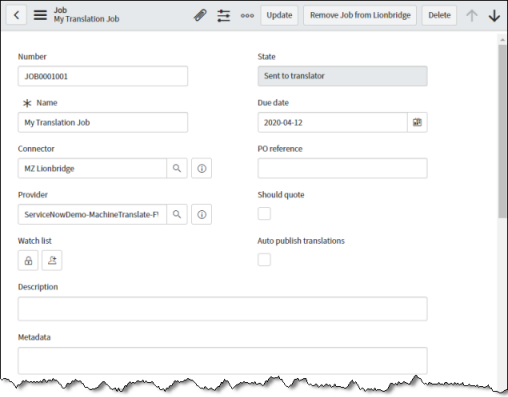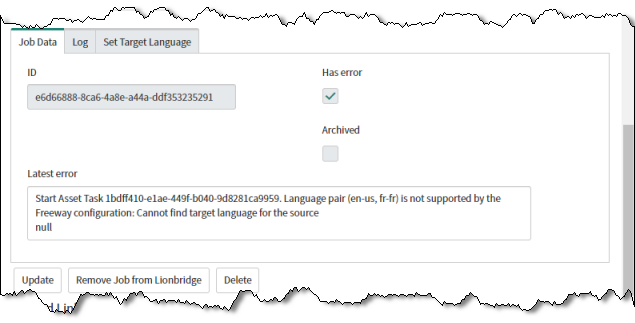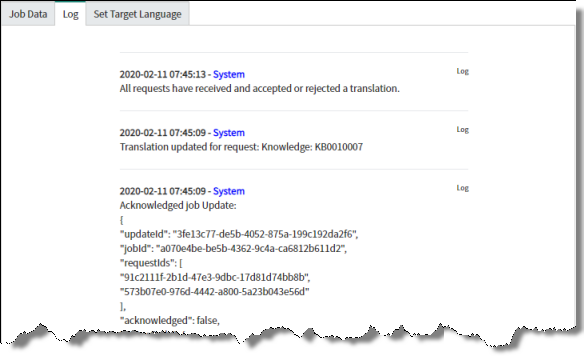Viewing Job Details
4 minute read
The Job dialog box displays detailed information about a job in any state.

This dialog box opens when you click a link in the Number column in the Jobs page or pop-up window.
- For a description of the Jobs page, see Viewing All Jobs.
- For a description of the Jobs pop-up window, see Viewing Your Translation Summary.
Note: Some fields may be editable, depending on the job state. For example, the fields of a job in Published state are not editable, while the fields of a job in Sent to translator state may be editable. For information about modifying editable fields, see the corresponding descriptions in Creating a Job.
The Job dialog box displays the following information about a job in any state:
| Field | Description |
|---|---|
| Number | The job number, which is a unique identifier for your job, starting with JOB, and following by a seven-digit number. It is assigned by the Connector when you create a job. |
| Name | The name of the job. |
| Connector | The name of the Connector configuration to the Clay Tablet. For more information, refer to the Lionbridge Connector for ServiceNow Installation and Configuration Guide. |
| Provider | The translation provider for this job. |
| Watch list | The list of users who receive notifications about the state of this job. |
| State | The current translation state of the job. For a list and description of translation states, see Translation States. |
| Due date | The requested translation deadline, when the job creator expects the translated content to return, in YYYY-MM-DD format. |
| PO reference | The purchase order number referenced for payment of this job. |
| Should quote | If this check box is selected, then the translation provider was instructed to send a quote before starting the translation process. |
| Auto publish translations | If this check box is selected, then when this job is complete, the Connector automatically publishes the translated content. |
| Description | The description of the job. |
| Metadata | Additional information sent to the translation provider. |
- To view additional information about the job, click the Job Data tab.

The Job Data tab displays the following information:
| Field | Description |
|---|---|
| ID | The unique job identifier assigned by the Connector. This identifies the job when it is processed by the Clay Tablet. |
| Has error | Indicates whether the job has an error. |
| Archived | Indicates whether the job is archived. |
| Latest error | Displayed only if the Has error check box, described above, is selected. Displays the latest error, which can be either from the Clay Tablet or Lionbridge Freeway, depending where the error occurred. |
- To view a list of all entries in the log file about this job, click the Log tab.

- To view the target languages for this job, click the Set Target Language tab.

- To view all the requests in the job, which are the individual content items to send for translation, scroll down to the Related Links section.

The Related Links section displays the following information about each request (content item) in the job:
| Column | Description |
|---|---|
| Clicking this icon opens the Request pop-up window, displaying detailed information about the request. For a detailed description, see Viewing Request Details. | |
| Number | The request number, which is a unique identifier for your request, starting with LRQ, and followed by a seven-digit number. By default, the request number is one number higher than the last request created. Clicking the number opens the Request dialog box, where you can edit the request. For a detailed description, see Editing a Request. |
| Name | The name of the request. This includes the content type, such as a Knowledge Article, followed by the name or number of the content item. |
| State | The current translation state of the request. For a list and description of translation states, see Translation States. |
| Has Error | Indicates whether this request has an error. This is either: * true: The request has an error. * false: The request does not have an error. |
| Updated | The last time this request was updated, in YYYY-MM-DD HH:MM:SS format. |
Actions
You can perform the following actions by clicking the corresponding buttons at the top of the dialog box.
- Depending on the job state, you may be able to modify some of the values in this dialog box. Click Update to save any changes.
- To remove this job from the Connector, click Remove Job from Lionbridge. A message box opens, confirming that you want to remove this job. Click OK to continue. The job remains in ServiceNow, and you can send it for translation another time.
Recommendation: Contact Lionbridge before removing a job, as this disrupts translation work in progress.
- To remove this job and the translation requests within it from the Connector and from ServiceNow, click Delete. A message box opens, confirming that you want to delete this job. Click Delete to continue.
Warning: Deleting a job deletes the translation requests within it. To send the corresponding content items for translation after deleting a job, you must create a new job.